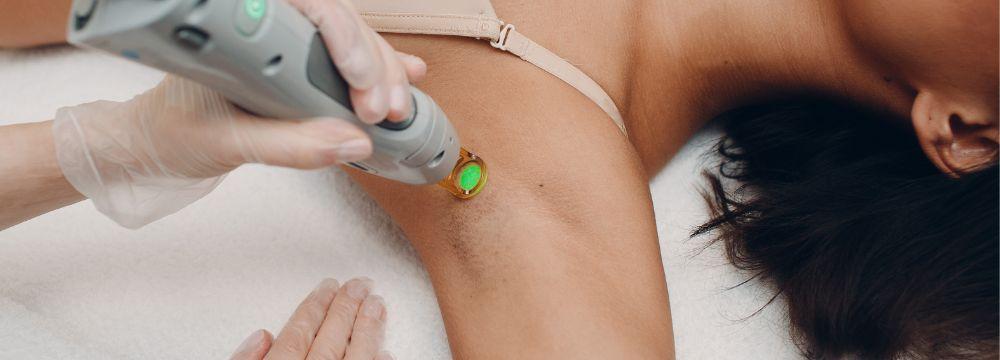Laser Hair Removal and Different Skin Types (The Fitzpatrick Scale)

If you’re considering removing unwanted hair, getting the most accurate information about today’s technologies is important. Using the wrong approach could mean you don’t get the desired results – but what’s even worse than spending money on a procedure that doesn’t work? Having unwanted or even permanent damage to your skin because of the process. To avoid this, we will dive into different technologies for laser hair removal and hopefully help you determine which will be most effective for your skin type.
Laser hair removal has a long and varied history – it was first discovered in the 1960s inadvertently while researching the development of ruby lasers. Later came the Nd: YAG laser, although initially, this was not permanent and only offered a reduction of hair. Finally, in the 1990s, a more permanent and effective solution was proposed and eventually gained FDA approval using an Alexandrite laser.
Today, we have at least five different laser hair removal approaches, with some devices even being approved for at-home use. Laser hair removal is one of the most common and readily accessed treatments used in dermatology. It is important to note that while most people undergo laser hair removal for aesthetic purposes, there are several medical reasons for having hair removed for both men and women. Pseudofolliculitis barbae is a painful condition usually experienced by men with beard hair that becomes chronically ingrown and can significantly benefit from laser hair removal. Hidradenitis suppurativa is another condition thought to result from occluded and inflamed hair follicles that can be improved with permanent hair removal.
The main differences regarding approaches for laser hair removal include which skin type and hair color combination each technology is best suited for. Understanding the Fitzpatrick skin type scale is integral for safe and effective laser hair removal. The Fitzpatrick scale measures skin darkness and ranges from I to VI. Knowing where you fall can make a big difference in determining which technology is right for you.
- Fitzpatrick skin type I is the fairest, with skin that never tans. Usually, people with this skin type have blonde or red hair.
- Fitzpatrick skin type II is also relatively fair; they may have blonde or light brown hair.
- Fitzpatrick skin type III is a common skin type with a medium tone that can tan with UV exposure. Often people with this skin type have darker hair.
- Fitzpatrick skin type IV has brown skin that rarely burns and dark brown hair.
- Fitzpatrick skin type V has dark brown skin that never burns and usually has black hair.
- Fitzpatrick skin type VI is the darkest skin type that never burns and has black hair.
Laser hair removal occurs through a photothermal reaction process where the hair follicle is damaged while leaving the skin unaffected. Energy enters the skin from a laser in pulses and is delivered to the desired area through a mechanism known as photothermolysis. If too much energy is used, it does not appropriately target the hair follicle and damages the surrounding tissues. This can result from using the wrong type of laser or suboptimal settings, leading to unwanted side effects, including burns, hypopigmentation, and scarring. Many lasers use the contrast between the hair and the surrounding skin to target the hair successfully. For example, dark hair on light skin is more likely to be successfully treated than dark hair on dark skin or light hair on fair skin. With technological advances, some lasers have overcome contrast challenges using longer pulses and cooling systems.
For skin types I-IV, ruby lasers, alexandrite lasers, newer diode lasers, and Intense Pulsed Light (IPL) are all good options. However, for darker skin types, the Nd: YAG laser is a more effective and safer option. A diode laser is also a good option for darker skin types, with relatively few side effects, while a ruby laser can cause dyspigmentation in these darker skin types and pain during the treatment. Another factor for darker skin types is the number of sessions required. Up to ten treatments may be needed for skin types IV, V, and VI, whereas 4-6 treatment sessions may be sufficient for lighter skin types.
Newer lasers have begun combining wavelengths to improve their efficacy and help treat patients with different skin tones and hair colors. For example, diode lasers may have been set to a single wavelength of 800nm, while an Nd: YAG could be targeted at the 1064nm wavelength. By combining these, some lasers can simultaneously cover shorter and longer wavelengths. IPL, although not a true laser, also covers a broader spectrum of light. IPL is slightly less effective than true lasers for eliminating unwanted hair but has many benefits in the form of fewer possible risks.
A recent meta-analysis showed that IPL was comparable to diode and alexandrite lasers in safety and side effects, though it was less painful. So, although IPL is slightly less effective, it is safe for all skin types, including darker ones.
Traditionally blonde hair has also proven challenging for laser hair removal- since it has little contrast against the surrounding skin. Recent advances have allowed for some improvement by using a novel dye system that artificially pigments the hair before the energy pulse. Longer pulses with deeper penetration are also being developed specifically for blonde hair.
Finding a qualified provider who understands traditional and newer technologies is critical to developing an effective plan for permanent hair removal. If you are considering at-home lasers or a medical spa, be sure to target dark hair on light skin to reduce the risk of problems. Otherwise, you could have unwanted side effects or waste your money. This is why, when it counts, we encourage you to visit a qualified and experienced dermatology practice like North Atlanta Dermatology. Our dermatologists have the deep medical background and knowledge to make treatments most effective with the fewest possible side effects.
